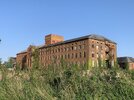History
Tonedale Mills including the dye works was a large wool factory in the SW of the UK owned by Fox Brothers & Co. It was most famous for the production of "Taunton serge", and later the khaki dye used by the British Army. The mill was established in the middle of the eighteenth century, and thrived during the industrial revolution. At its peak, around 6,500 metres (21,300 ft) of material was produced at the factory each day.
During the reign of Queen Elizabeth I, the Were family of Wellington began producing serge on a small scale. In the early 1700s, Edward Fox married Hannah Were, and soon took over the trade. The wool industry thrived in areas used for sheep farming, like Somerset, and Taunton serge was particularly popular due to its balance between being light-weight and yet sufficiently thick. The Were family established Tone Mills in 1754, and over the next seventeen years, the family's assets quadrupled as the industry thrived. Thomas Fox, after learning the trade in Germany and the Netherlands for three years, entered the business as a partner, and formally founded the company as Fox Brothers in 1772. The technological breakthroughs of the late 18th century revolutionised textile manufacture. In the 1790s, Fox Brothers purchased a complex of buildings in Tonedale known variously as the "Old Town Mills" or the "Old Flour Mills" to centralise their processes. This move facilitated an increase in both quality and quantity, while cutting costs as other production was brought in-house; basket weaving, joinery, book binding and metalworking was all carried out on the site.
The site is notable for having remains of each phase of power generation: water, steam and electricity, as when steam power was introduced, Fox Brothers opted to retain their water management system as it might prove useful. The site was continually growing through the nineteenth century, and at its peak employed around 3,600 people around Wellington, and produced 6,500 metres (21,300 ft) of material each day. At the Tonedale complex, dyers working for Fox Brothers developed a khaki dye which was used by the British soldiers in the Second Boer War. The complex was the largest woollen mill in South West England, and was rare in integrating ancillary processes on the same site. The mill continued to produce cloth on a large scale until it downsized in the 1980s, due to cheap textile imports from the Far East.
This is a absolutely stunning little place, absolutely amazing!! It is a bit like walking into a museum with all the machinery still in situ. I am definitely planning a return trip in the future....










Many thanks for looking....
Tonedale Mills including the dye works was a large wool factory in the SW of the UK owned by Fox Brothers & Co. It was most famous for the production of "Taunton serge", and later the khaki dye used by the British Army. The mill was established in the middle of the eighteenth century, and thrived during the industrial revolution. At its peak, around 6,500 metres (21,300 ft) of material was produced at the factory each day.
During the reign of Queen Elizabeth I, the Were family of Wellington began producing serge on a small scale. In the early 1700s, Edward Fox married Hannah Were, and soon took over the trade. The wool industry thrived in areas used for sheep farming, like Somerset, and Taunton serge was particularly popular due to its balance between being light-weight and yet sufficiently thick. The Were family established Tone Mills in 1754, and over the next seventeen years, the family's assets quadrupled as the industry thrived. Thomas Fox, after learning the trade in Germany and the Netherlands for three years, entered the business as a partner, and formally founded the company as Fox Brothers in 1772. The technological breakthroughs of the late 18th century revolutionised textile manufacture. In the 1790s, Fox Brothers purchased a complex of buildings in Tonedale known variously as the "Old Town Mills" or the "Old Flour Mills" to centralise their processes. This move facilitated an increase in both quality and quantity, while cutting costs as other production was brought in-house; basket weaving, joinery, book binding and metalworking was all carried out on the site.
The site is notable for having remains of each phase of power generation: water, steam and electricity, as when steam power was introduced, Fox Brothers opted to retain their water management system as it might prove useful. The site was continually growing through the nineteenth century, and at its peak employed around 3,600 people around Wellington, and produced 6,500 metres (21,300 ft) of material each day. At the Tonedale complex, dyers working for Fox Brothers developed a khaki dye which was used by the British soldiers in the Second Boer War. The complex was the largest woollen mill in South West England, and was rare in integrating ancillary processes on the same site. The mill continued to produce cloth on a large scale until it downsized in the 1980s, due to cheap textile imports from the Far East.
This is a absolutely stunning little place, absolutely amazing!! It is a bit like walking into a museum with all the machinery still in situ. I am definitely planning a return trip in the future....
Many thanks for looking....



 .
.